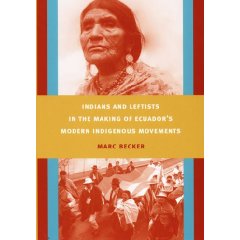
| The Book |
| Chronology |
| Acronyms |
| Glossary |
| Biographies |
| Revolts |
| Documents |
| Data |
This is an Electronic Appendix of documents to accompany my book Indians and Leftists in the Making of Ecuador’s Modern Indigenous Movements (Duke University Press, 2008).

Journal of Latin American Studies 41, no. 1 (February 2009): 191-92
Review
Marc Becker, Indians and Leftists in the Making of Ecuador's Modern Indigenous Movements (Durham, NC, and London: Duke University Press, 2008), pp. xxv+303, $79.95, $22.95 pb.
DONNA LEE VAN COTT
University of Connecticut
Social science accounts of indigenous movements in Ecuador typically begin with the 1990 Nationwide Uprising, which gained indigenous mobilisation in this politically volatile Andean country international attention. Historian Marc Becker shows how that significant event, and a series of social movements and political party victories that followed, are part of a long history of activism to advance a radical reform agenda addressing the dual bases of indigenous oppression: exploitation as a reviled ethnic and racial group and as a peasant class trapped in relations of capitalist agricultural domination. Framing contemporary political mobilisation within a longer historical perspective, Becker debunks much of the common wisdom concerning the origins and development of one of the most important contemporary indigenous movements in the Americas. Becker narrates the history of indigenous organising from the 1920s to the early 2000s, with emphasis on highland indigenous-peasant struggles. Particular attention is given to activity in Cayambe, a community north of Quito which was the site of important activism in the 1930s, 1940s and 1950s. Whereas social scientists like Amalia Pallares, Melina Selverston-Scher, José Antonio Lucero, and Leon Zamosc have published detailed accounts of the emergence of Ecuador's most important contemporary indigenous organisation (the Confederation of Indigenous Nationalities of Ecuador, CONAIE) Becker focuses on key precursor organisations, particularly the Ecuadorian Indian Federation (FEI), formed in 1944.
Social scientists commonly criticise Ecuador's leftist organisations and parties for having historically ignored the ethnic nature of indigenous peoples' claims for rights and for subordinating them to white-mestizo organisational hierarchies. But Becker shows that rural indigenous peasants formed close ties of mutual cooperation with urban leftist intellectuals in the 1920s. Indigenous leaders participated actively in the formation of the Ecuadorian Socialist Party and the Ecuadorian Communist Party, held important positions in these organisations, and helped to define the leftist political agenda in the first half of the 20th century. In turn, leftist intellectuals and socialist analysis were profoundly important in shaping indigenous discourse and introducing new forms of protest and a number of leftist mestizos dedicated themselves to fighting on behalf of indigenous economic, social, political and cultural rights. As indigenous activists shifted in the 1960s from an agenda emphasising improved working conditions on haciendas toward claims for return of agricultural land to indigenous communities, indigenous-rural and leftist-urban alliances began to break down. Agrarian reform in the 1960s and 1970s reduced the political relevance of important leftist organisations like the FEI. Leftist mestizos increasingly excluded indigenous leaders from top positions in their organisations and political parties and reduced their attention to indigenous rights, inculcating the contemporary image of a classist, racist left insensitive to indigenous claims based in culture and nationality. In the 1980s, urban leftists exaggerated their role in supporting earlier indigenous mobilisations in an effort to take advantage of the political momentum of the indigenous movement. Becker argues that ‘it is this memory of increasing paternalism possibly complicated by interpersonal conflicts, rather than earlier patterns of actively struggling together as equals, that led to increased tension between Indigenous movements and the left’ (p. 150).
Becker also takes on claims that earlier indigenous mobilisations almost exclusively emphasised classist-socialist themes which were later replaced with ethnic-cultural claims. Rather, indigenous organisations consistently have expressed the ‘double dimension’ (p. 168) (class and ethnic) of indigenous oppression and rights claims. The FEI demanded the right to self-determination of peoples in its newspaper in the 1940s, long before the transnational indigenous-rights movement made this a common rallying cry in the 1980s. Although contemporary indigenous movements in the 1980s adopted a discourse of promoting indigenous nationalities in ways that echo nationalist movements elsewhere in the world, economic and social issues related to Indians' class position remain a central part of the indigenous-rights agenda.
One of the most valuable and novel components of Becker's argument is his provision of ample evidence that indigenous women played a fundamental leadership role in indigenous and leftist politics in the first half of the 20th century. Indigenous women such as Dolores Cacuango participated in the founding of seminal leftist parties and the FEI and risked their lives participating in protests, land occupations, marches and strikes. But as indigenous movements entered formal politics in the 1990s, indigenous women suffered a loss in terms of their representation in leadership. Becker attributes this in part to indigenous organisations' adoption of mainstream Ecuadorian gender norms and the gradual loss of the gender complementarity that characterises some Andean indigenous cultures. This is also attributable, I would argue, to the greater desirability of leadership roles in contemporary indigenous organisations and development NGOs, which carry with them access to economic resources, as well as the increased availability of elected and appointed government offices for indigenous peoples. As in Bolivia, indigenous men have monopolised these coveted positions. Nevertheless, modern female indigenous leaders like Blanca Chancoso and Nina Pacari carry on the tradition of devotion to indigenous rights and empowerment. The showcasing of two generations of female indigenous leaders on the book's jacket exemplifies the serious and sustained attention Becker gives to women's role in indigenous movements.
Indians and Leftists in the Making of Ecuador's Modern Indigenous Movements corrects numerous misconceptions about indigenous movements in Ecuador that are likely to be relevant to understanding experiences in neighboring countries. It is the most comprehensive and insightful narrative available of the development of relations between an important indigenous movement and the political left. The book also fills a gap in our understanding of the historic role of indigenous women in the success of indigenous mobilisations in Ecuador. There is a need now for more studies of the failure of the Ecuadorian indigenous movement to maintain momentum and to consolidate its accomplishments after 2002, as well as more intensive and critical analyses of gender imbalances in contemporary Andean indigenous movements.